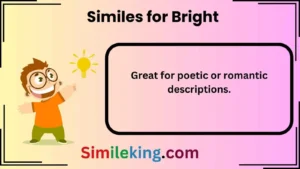simile examples are one of the most powerful literary devices used to create vivid imagery and enhance descriptions.
They compare two unlike things using the words “like” or “as”, making language more engaging and expressive.
Whether in everyday conversation, literature, or creative writing, simile like examples help convey emotions, clarify meanings, and add depth to storytelling.
In this article, we will explore simile examples categorized by their usage.
From nature and emotions to humor and exaggeration, this guide will help you understand how to use similes effectively example simile.
Additionally, we provide 12 texting-friendly examples to help you incorporate similes into casual digital conversations.
What Is a Simile?
A simile is a figure of speech that directly compares two different things to highlight similarities. It differs from a metaphor, which makes an implicit comparison without using “like” or “as”.
🔹 Simile example: “Her smile was as bright as the sun.”
🔹 Metaphor example: “Her smile was the sun.”
Similes create strong mental images, making descriptions more relatable and impactful.
Common Similes in Everyday Language
1. Similes Describing People

These similie examples highlight characteristics, behaviors, or emotions.
- As brave as a lion – Someone who is very courageous.
- As wise as an owl – A person with great wisdom.
- As strong as an ox – Someone extremely powerful.
- As busy as a bee – A hardworking individual.
- As quiet as a mouse – A very silent or shy person.
✅ Example in a sentence: “Even with all the chaos around her, she remained as calm as a cucumber.”
2. Similes Related to Nature

These comparisons use elements of nature to describe people, feelings, or situations.
- As fresh as a daisy – Looking bright and well-rested.
- As light as a feather – Very lightweight.
- As fast as lightning – Extremely quick.
- As cold as ice – Lacking warmth or emotion.
- As clear as crystal – Very easy to understand or transparent.
✅ Example in a sentence: “His instructions were as clear as crystal, so no one had trouble following them.”
3. Similes for Emotions and Feelings

These similes express emotions in a creative way.
- As happy as a clam – Feeling extremely happy.
- As mad as a hornet – Very angry or furious.
- As stubborn as a mule – Very determined or unwilling to change.
- As nervous as a cat in a room full of rocking chairs – Extremely anxious.
- As cool as a cucumber – Remaining calm under pressure.
✅ Example in a sentence: “Despite the difficult situation, he stayed as cool as a cucumber.”
4. Funny and Exaggerated Similes

These similes are often used in humorous contexts.
- As slow as a snail – Moving very slowly.
- As lazy as a sloth – Someone who avoids work.
- As blind as a bat – Having very poor eyesight.
- As hungry as a wolf – Extremely hungry.
- As ignorant as a rock – Lacking intelligence.
✅ Example in a sentence: “After skipping lunch, I was as hungry as a wolf.”
5. Similes for Everyday Situations
These similes are commonly used in daily speech.
- As smooth as silk – Very soft or refined.
- As tough as nails – Very strong or resilient.
- As cheap as dirt – Extremely inexpensive.
- As fit as a fiddle – In very good health.
- As sharp as a tack – Very intelligent or perceptive.
✅ Example in a sentence: “Grandpa may be old, but he’s still as sharp as a tack.”
12 Similes for Texting
When sending messages, using similes can make conversations more engaging and fun. Here are 12 texting-friendly similes that fit various moods:
- “I’m as tired as a bear in hibernation 😴.”
- “You’re as funny as a stand-up comedian 😂.”
- “This WiFi is as slow as a turtle 🐢.”
- “My patience is as thin as a thread right now! 😤”
- “I’m as happy as a kid in a candy store! 🍭😆”
- “That idea is as bright as a lightbulb 💡!”
- “My phone battery is as dead as a doornail 🔋💀.”
- “You’re as sweet as honey 🍯!”
- “My room is as messy as a tornado hit it 🌪️.”
- “This test is as hard as a rock! 😩”
- “My schedule is as packed as a subway during rush hour 🚇.”
- “He’s as lost as a tourist without Google Maps 🗺️.”
examples of a simile
When choosing a example of simile, consider the context, tone, and audience:
🔹 For professional settings: Use similes that are clear and neutral. (e.g., “The instructions were as clear as crystal.”)
🔹 For casual conversations: Go for fun and relatable ones. (e.g., “I’m as hungry as a wolf!”)
🔹 For creative writing: Use vivid and unique comparisons. (e.g., “Her laughter was like a melody on a spring morning.”)
Avoid overusing similes in formal writing, and ensure they match the tone of your message.
Conclusion
Similes are a fantastic way to add color, clarity, and personality to language. Whether you’re writing an essay, crafting a novel, or sending a quick text, using similes can make your words more expressive and engaging. By selecting the right simile for the situation, you can enhance communication and make your message more impactful.
Try incorporating similes into your daily speech or writing—you might find that they make your expressions as lively as a fireworks display! 🎇





